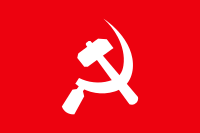Communist Party of Nepal (Unity Centre–Masal)
Communism in Nepal
 Leaders
Current groups
Defunct groups
Related articles
|
Communist Party of Nepal (Unity Centre–Masal) (Nepali: नेपाल कम्युनिष्ट पार्टी (एकताकेन्द्र–मसाल)) was an underground communist political party in Nepal.[1] CPN(UC–M) was formed in 2002 through the merger of Communist Party of Nepal (Unity Centre) and Communist Party of Nepal (Masal). The merger of the two parties was announced at a public meeting on April 22, 2002 by the general secretaries of the two parties, Ram Singh Shris of CPN(Masal) and Narayan Kaji Shrestha (Prakash) of CPN(UC).[2][3][4] The CPN(UC–M) adhered to Marxism–Leninism–Mao Zedong Thought as its ideological basis. The founding general secretary of CPN(UC–M) was Mohan Bikram Singh. The two electoral mass fronts of the two parties merged into Janamorcha Nepal. The Janamorcha Nepal joined the Seven Party Alliance and took active part in the 2006 Loktantra Andolan.
CPN(UC–M) favoured a negotiated settlement of the Nepalese internal conflict. Their proposal, put forward together with other leftists, was to hold a constituent assembly. The party opposed US involvement in Nepal.
After the fall of the royal dictatorship in April 2006 the CPN(UC–M) was split in four. One minor faction formed the Communist Party of Nepal (2006).[5] Two other, and more significant, splits emerged during 2006. First Mohan Bikram Singh formed a parallel CPN(UC–M), taking with him three MPs of Janamorcha Nepal (the faction led by Chitra Bahadur K.C., which had formed a parallel Janamorcha Nepal in May 2006). A core issue behind the split was the opposition of Singh towards joining the interim government.[6] The other split emerged as Shris broke away (taking two Janamorcha Nepal MPs with him).[7] Shris' faction later merged into the Communist Party of Nepal (Unified).
Prakash was the general secretary of the post-split CPN(UC–M).[1][8]
It merged with the Communist Party of Nepal (Maoist) to form the Unified Communist Party of Nepal (Maoist) in early January 2009.[9]
See also
- Communist Party of Nepal (Marxist–Leninist–Maoist Centre)
- Communist Party of Nepal (Unity Centre)
- List of communist parties in Nepal
References
- 1 2 :: National Election Monitoring Alliance, Nepal
- ↑ Political Developments in Nepal - 2002
- ↑ eKantipur.com - Nepal's No.1 News Portal
- ↑ Nepalnews.com (newsflash) Arc372)
- ↑ News
- ↑ Nepalnews.com Mercantile Communications Pvt. Ltd
- ↑ http://www.digitalhimalaya.com/collections/journals/nepalitimes/pdf/Nepali_Times_332.pdf
- ↑ eKantipur.com - Nepal's No.1 News Portal
- ↑ http://english.people.com.cn/90001/90777/90851/6573327.html
External links
- The Tasks Ahead for the Communists – contribution of CPN(UC–M) to the 13th International Communist Seminar